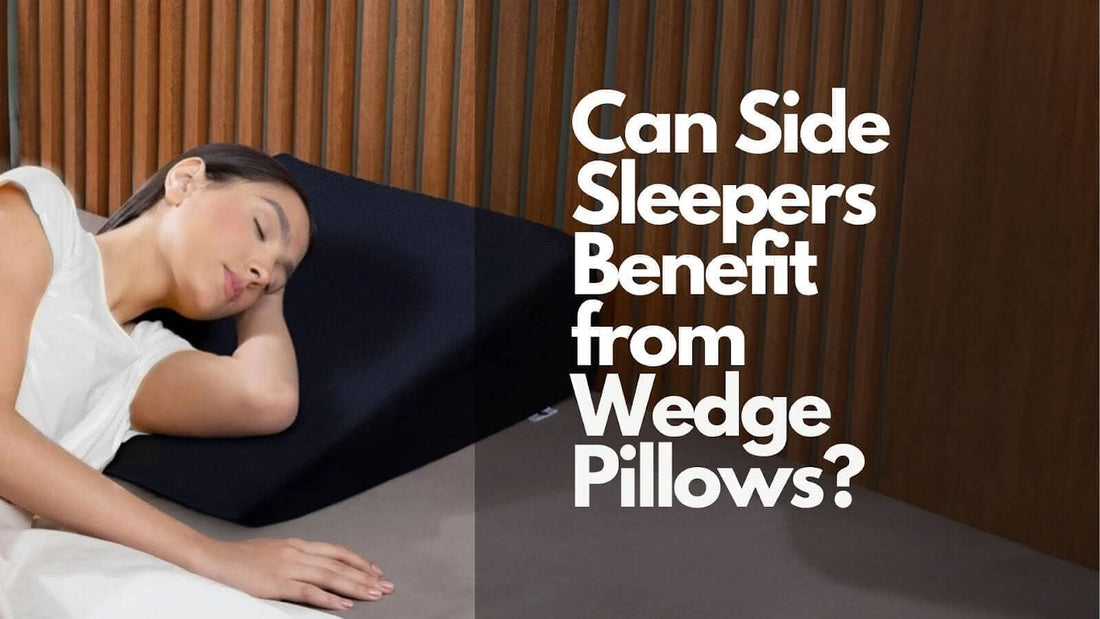Introduction: The Side Sleeper's Dilemma
Are you a side sleeper who has been wondering about wedge pillows? You might have seen them online or in stores and thought, "Can I use that, or are they just for back sleepers?" Many people who sleep on their side have the same question. Let's explore the world of wedge pillows and find out if they can help you sleep better.
Top 5 Myths about Side Sleeping: Let's Set the Record Straight
Before we talk about wedge pillows for side sleepers, let's look at some common myths about sleeping on your side:
Myth #1 "Side sleeping is bad for your back"
Actually, side sleeping can be good for your spine when you do it correctly. The important thing is to keep your body in the right sleep posture with proper support.
Myth #2 "You need a very soft pillow for side sleeping"
Softness is nice, but what you really need is a pillow that supports your head and neck. If the pillow is too soft, your head might sink too low and cause neck and shoulder pain.
Myth #3 "Wedge pillows are only for back sleepers"
This is the big myth we want to talk about. Wedge pillows can be great for side sleepers too, with a few small changes.
Myth #4 "Side sleeping causes wrinkles"
There is a little bit of truth here. Pressing your face into a pillow can cause some wrinkles. But using a pillowcase made of silk or other smooth materials can help.
Myth #5 "You can't change your sleep posture"
This is not true! You can train yourself to change from sleeping on your stomach to sleeping on your side. It just takes time and the right pillow suitability.
Are you interested in how the perfect pillow can help you sleep better? Take a look at The White Willow's collection of wedge pillows!
Can Side Sleepers Use a Wedge Pillow?
Now, let's answer the main question. Can wedge pillow side sleepers benefit from these specialized pillows? Yes, they can! Here's why:
- The raised part of the pillow can help with acid reflux and reduce snoring.
- The slope can make it easier to breathe and keep airways open.
- With the right position, a wedge pillow can relieve pressure on your shoulders and hips.
How Wedge Pillows Support Side Sleepers
You might be wondering, "How does a wedge pillow actually help people who sleep on their side?" Here are some ways:
- Spinal Alignment: The gentle slope helps keep your spine straight from your head to your feet, promoting proper sleep posture.
- Pressure Relief: By spreading your weight more evenly, a firm pillow like a wedge can reduce pressure on your hips and shoulders. You won't wake up with aches and pains.
- Better Breathing: The raised position can open up your airways. This can help reduce snoring and sleep apnea.
- Acid Reflux Relief: Even for side sleepers, the slope can help keep stomach acid from coming up into your throat.
Do you want to try a wedge pillow? The White Willow has options that are great for side sleepers. See them here!
What Changes Can Side Sleepers Make?
Using a wedge pillow for side sleeping might take a little bit of getting used to. Here are some tips:
- Pillow Placement: Try moving the wedge pillow down a bit, so it's under your upper body instead of just your head and neck.
- Extra Support: You can still use your regular pillow on top of the wedge for extra neck support.
- Leg Position: Put a small pillow between your knees. This will help your hips stay in line, especially important for pregnant women.
What Challenges Do Side Sleepers Face with Wedge Pillows?
Switching to a wedge pillow as someone who sleeps on their side might not be easy at first. Here are some things you might notice:
- Finding the Right Angle: The slope that works for back sleepers might feel too steep when you're on your side.
- Shoulder Pressure: If you don't position the pillow right, the wedge shape can put extra pressure on your shoulder, leading to shoulder pain.
- Pillow Movement: The pillow might try to move around during the night.
But don't worry – with a little patience and practice, you can find a way to make it work. The health benefits of good sleep are worth the effort!
The Science of Side Sleeping: Why Posture Matters
Let's talk about the science of sleep for a moment. When you sleep on your side with good posture, it can be very good for your health:
- It can help reduce back and neck pain.
- Your digestion might get better, especially compared to sleeping on your stomach.
- There's even some evidence that left-sided sleeping is good for your brain and heart health.
The key is to keep your body in a straight line from your head to your toes, similar to the fetal position. A well-designed wedge pillow can help with this by supporting you in all the right places.
Do you want to learn more about how The White Willow's wedge pillows are designed for your health? Click here.
Expert Opinions: What Sleep Specialists Say
We asked some sleep experts what they think about wedge pillows for side sleepers. Here's what they said:
Dr. Sleepwell: "Wedge pillows are usually recommended for back sleepers, but they can be a good choice for side sleepers too. The important thing is to find the right angle and use extra support where you need it."
Professor Pillowtalk: "For side sleepers, I usually suggest a wedge pillow with a lower slope, around 15-20 degrees. This gives you the benefits of being raised without feeling like you're sleeping on a steep hill."
Choosing the Right Wedge Pillow for Side Sleeping
If you're ready to try a wedge pillow, how do you choose the right one? Here are some things to think about:
- Slope Angle: Look for a lower angle (15-30 degrees) for side sleeping comfort. You want a gentle rise, not a mountain!
- Material: Memory foam pillows can be great for side sleepers. They mold to your body and relieve pressure points.
- Size: Make sure the pillow is wide enough for your shoulders to fit comfortably. You don't want to feel squished.
- Adjustability: Some wedge pillows have layers you can remove. This lets you customize the pillow to your needs.
Find your perfect side sleeping wedge pillow at The White Willow. We have options for every type of sleeper!
The White Willow Difference: Comfort Tailored for Side Sleepers
At The White Willow, we understand that every sleeper is different. That's why our wedge pillows are made to be versatile. Whether you always sleep on your side or you change positions during the night, our pillows can adapt to give you the support and comfort you need.
We're not just here to sell you a pillow. We want to help you invest in your sleep and your health.
Conclusion: Embracing the Wedge as a Side Sleeper
So, can side sleepers benefit from wedge pillows? Absolutely! It might take some getting used to and a bit of adjusting, but the potential side sleeping benefits for your sleep posture, comfort, and overall health make it worth trying.
Remember, the key is to find the setup that works for you. Don't be afraid to experiment until you find your perfect sleep position. Your best night's sleep might be just a wedge away!
Are you ready to take your side sleeping to the next level? Check out The White Willow's collection of wedge pillows and find the one that's right for you. Sweet dreams!
Transform your side sleeping experience with The White Willow's premium wedge pillows. Shop now and wake up feeling great!
FAQ
What angle wedge pillow is best for side sleepers?
For side sleepers, a wedge pillow with a lower slope of 15-30 degrees is usually best. This gives you gentle support without making you feel uncomfortable or out of line.
Can using a wedge pillow help with snoring for side sleepers?
Yes, wedge pillows can help side sleepers snore less by raising the upper body a little bit. This can help keep your airways open, which can reduce snoring and make it easier to breathe while you sleep.
How long does it take to get used to sleeping on a wedge pillow?
Most people get used to sleeping on a wedge pillow in 1-2 weeks. It's important to be patient and keep trying, because your body might need time to adjust to the new sleeping position.
Are there any side effects of using a wedge pillow for side sleepers?
Some side sleepers might feel a little sore in their shoulders at first or feel like they're sliding off the pillow. These problems can usually be fixed by adjusting the pillow or using extra pillows for support where you need them.

